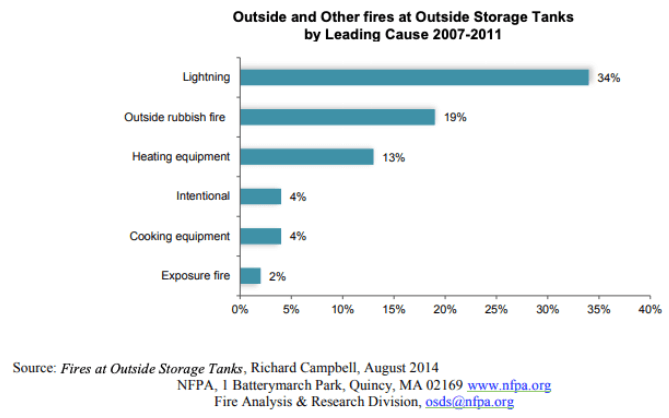Preventing Fire Risks in Gas Storage Facilities
Improvements in safety precautions, technology, and design have had a significant impact on reducing fires at storage facilities. In 1980, there were over 1100 outside storage tank fires in the U.S. resulting in an estimated $7 million in property damage. According to the NFPA incidents had dropped by 76% by 2011, resulting in 301 fires and $4 million in property damage.
Although advances in storage tank materials and industrial heating technology have effectively reduced fire risks, they have not been able to stamp them out altogether. Some of the risk factors fall outside of the direct control of humans. For example, lightning is the leading contributor to outdoor storage fires.
To reduce the risks of fires in gas storage facilities, careful selection of equipment and materials are necessary.
Tank Type & NEMA Rating
The type of tank must be carefully matched for suitability to the activities, conditions, and compounds of the stored medium. One of the most recognizable vessels in gas storage facilities is the liquid natural gas (LNG) storage tank.
An LNG storage tank is kept above ground for storage, or attached to LNG carriers for transport. They use insulated double containers allowing them to better control storage temperatures and maintain their liquid state.
If damage, heat exposure or other factors cause boiling and/or release of gasses/vapors pressure release devices are installed to release vapors. This release prevents violent ruptures, fires, and/or explosions.
In addition to tank type, extra care must be taken in the selection of NEMA ratings of equipment. The National Electrical Manufacturers Association (NEMA) sets standards detailing the design, production, and distribution of products. They determine specifics such as uniform ratings, testing, performance, and construction to allow manufacturers and purchasers to select the correct NEMA rating for specific applications.
In the gas industry common rating used include NEMA 4 (moisture resistant) and NEMA 7 (explosion-proof). NEMA rated digital control panels provide safety and precision heating for all heating applications.
Maintenance and Inspection
Regular maintenance and inspection are essential in reducing fire risks. Immersion heater maintenance keeps systems running efficiently and helps to prevent overheating and detect early symptoms of damage or sediment buildup.
As well, safety devices such as pressure release devices and temperature monitors should be regularly tested to ensure proper function. Inspect seals and connections for leaks, cracks, and fit. As well, perform a visual inspection of the tank for corrosion, peeling, and deformities that may indicate temperature or chemical damage.
Electric Heaters
For the oil and gas industry electric heaters are the ideal. Electric flanged, screw plug, and over-the-side heaters provide better performance and safety. These factors are essential when dealing with the production and storage of flammable and combustible products.
Electric power is more responsive, allowing for rapid adjustments and more accurate heating. As well, they avoid the risks of combustion heating, making them safer to use for direct heating of flammable and combustible mediums.
Their reliability and compatibility with thermowell assists, safety shutoff switches, and other accessories help to ensure safe and effective heating.
Automation
Automation is not just for improving operational efficiency and reducing personnel costs. It can also increase monitoring capabilities and responsiveness, resulting in greater risk reduction. Automation technology has had a direct impact on reducing the number of fire incidents at gas storage facilities.
Automated digital control panels do not require a human operator. As such, they are able to constantly monitor, adjusting to changes and discrepancies in real-time. Coupled with intelligent sensors, this allows them to turn heaters on and increase temperatures as needed, or activate shut off devices if temperatures or fluid levels fall outside of the safe range.
Response and Suppression Planning
Even with all the right preventative steps taken, it’s still important to have a plan for if a fire does occur.
Pre-Incident Planning/Survey
When opening a site, after making significant changes, or at intervals regulated by your state/district, conduct a pre-incident survey. During the survey, authorities come in and inspect the facility, identifying risks that can be addressed. As well, they use notes, information, and floor plans gathered to create a pre-incident plan that can be used for more efficient incident mitigation if emergency responders are required.
The survey also indicates construction elements, available water supplies, and potential obstruction risks that could interfere with response efforts in event of an emergency. Identifying these hazards in advance reduces risks and helps to protect property and personnel.
Safety Device
Another important factor to consider is the safety devices in place. Functioning alarms can alert personnel and emergency services quickly in event of an emergency. As well, incorporating suppression systems, like sprinklers, can help to reduce the damage until responders arrive.
Altogether, planning for response and suppression can help to reduce damages, losses, and human risk in the event a fire does occur.

